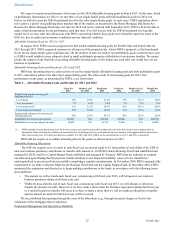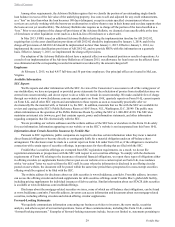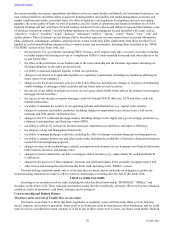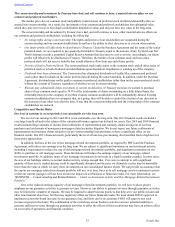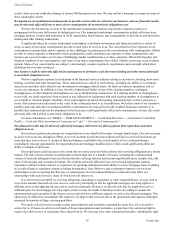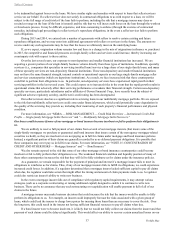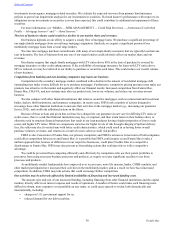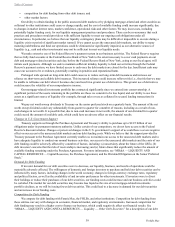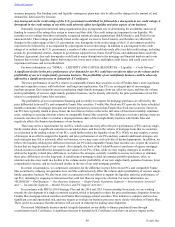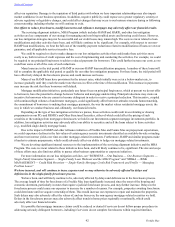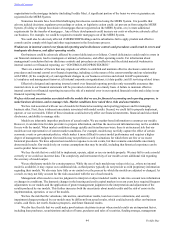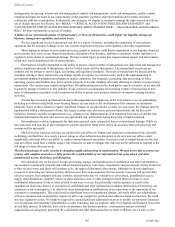Freddie Mac 2014 Annual Report Download - page 40
Download and view the complete annual report
Please find page 40 of the 2014 Freddie Mac annual report below. You can navigate through the pages in the report by either clicking on the pages listed below, or by using the keyword search tool below to find specific information within the annual report.
35 Freddie Mac
We are exposed to significant credit risk related to the subprime, Alt-A, and option ARM loans that back the non-agency
mortgage-related securities we hold in our mortgage-related investments portfolio.
Our investments in non-agency mortgage-related securities include securities that are backed by subprime, Alt-A, and
option ARM loans. We also hold non-agency mortgage-related securities backed by manufactured housing loans and home
equity lines of credit. The credit performance of the loans underlying these non-agency mortgage-related securities has declined
since 2007, and although it has stabilized in recent periods, it remains weak. Our net income could be adversely affected if the
population of non-agency mortgage-related securities that we intend to sell were to change or increase, as we would be required
to immediately recognize in earnings any unrealized losses on such securities. This population could change or increase for a
number of reasons, including as a result of changes in economic condition or our plans for the securities.
Since 2007, our net worth has at times been adversely affected by declines in the fair value of these investments. We may
experience additional fair value declines and losses in the future due to a number of factors, including increased delinquency
and loss rates on the underlying loans. The quality of the servicing performed on the underlying loans can significantly affect
the performance of these securities, including the timing and amount of losses incurred on the underlying loans and thus the
timing and amount of losses we recognize on our securities. Our ability to influence servicing performance is limited. In
addition, there is a general lack of transparency in the market for the non-agency mortgage-related securities we hold, and the
information disclosed by the trustees of the trusts that issued these securities is often not sufficient to allow us to adequately
analyze decisions made by servicers that may directly affect the cash flows on such securities. The servicing of the loans is
significantly concentrated among several specialty servicers, which may increase this risk. These specialty servicers are non-
depository financial institutions, and may not have the same financial strength, internal controls or operational capacity as
depository servicers. Any credit enhancements covering these securities may not prevent us from incurring losses.
For more information, see “MD&A — CONSOLIDATED BALANCE SHEETS ANALYSIS — Investments in
Securities,” "RISK MANAGEMENT — Credit Risk Overview — Single-Family Mortgage Credit Risk Framework and
Profile," and "— Institutional Credit Risk Profile — Agency and Non-Agency Mortgage-Related Security Issuers."
Declines in U.S. home prices or other adverse changes in the U.S. housing market could negatively impact our business and
financial results.
Our financial results and business volumes can be negatively affected by declines in home prices and other adverse
changes in the housing market. Although the single-family housing market improved in 2014, our credit losses remained high
compared to levels before 2009, in part because home prices have experienced significant cumulative declines in many
geographic areas since 2006. While we currently believe that home price growth rates will continue to moderate gradually
during the near term and will return towards growth rates that are consistent with long-term historical averages (approximately
2 to 5 percent per year), there can be no assurance that this will occur.
We prepare internal forecasts of future home prices, which we use for certain business activities, including: (a) hedging
prepayment risk; (b) estimating expected costs of new guarantee business; and (c) conducting portfolio activities. If future
home prices are lower than our forecasts, this could cause the return we earn on new single-family guarantee business to be less
than expected. In addition, home price changes that differ from our forecasts could affect prepayments and cause us to
incorrectly hedge prepayment risk. This could also result in higher losses due to other-than-temporary impairments on our
investments in non-agency mortgage-related securities (which would be recognized in earnings) or fair value declines on our
investments in non-agency mortgage-related securities (which would be recognized in AOCI). For more information, see
“MD&A — CONSOLIDATED BALANCE SHEETS ANALYSIS — Investments in Securities.”
Our business volumes (i.e., mortgage loan purchases and guarantee issuances) are closely tied to the rate of growth in
total outstanding U.S. residential mortgage debt, the size of the U.S. residential mortgage market, and the amount of new
mortgage originations. Total residential mortgage debt declined approximately 0.3% in the first nine months of 2014 (the most
recent data available) compared to a decline of approximately 1% in 2013.
While the multifamily market has experienced strong rent growth and occupancy trends in the past five years, these
trends are not likely to continue at their current pace as apartment fundamentals are already very favorable, with vacancy rates
near their lowest level since 2001. New supply of multifamily housing has been increasing in recent periods and could
potentially outpace demand, which could result in excess supply and rising vacancy rates. Any softening of multifamily
markets could cause delinquencies and credit losses relating to our multifamily activities to increase beyond our current
expectations.
We could incur significant losses in the event of a major natural disaster or other catastrophic event.
We own or guarantee mortgage loans and own REO properties throughout the United States. A major natural or
environmental disaster or similar catastrophic event in a regional geographic area of the United States could damage or destroy
residential real estate underlying mortgage loans we own or guarantee, or negatively affect the ability of homeowners to
continue to make payments on mortgage loans we own or guarantee. In turn, this could increase our serious delinquency rates
and average loan loss severity in the affected region, which could have a material adverse effect on our business and financial
Table of Contents


